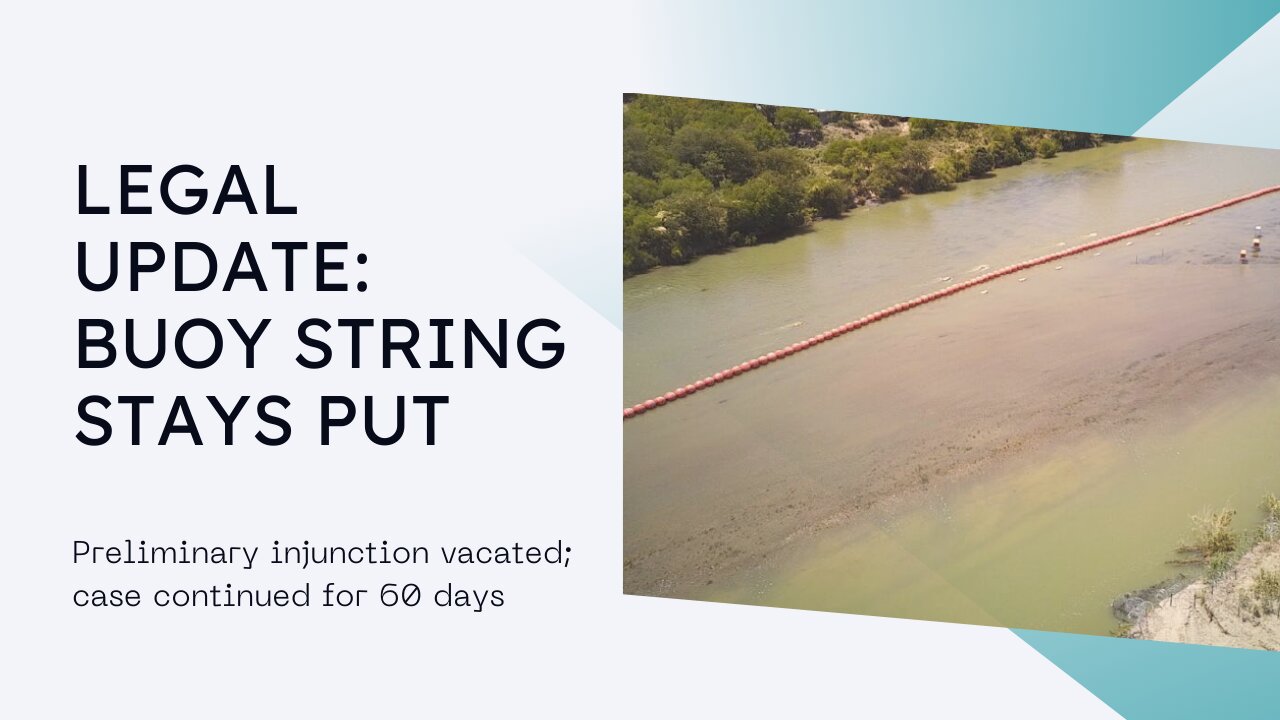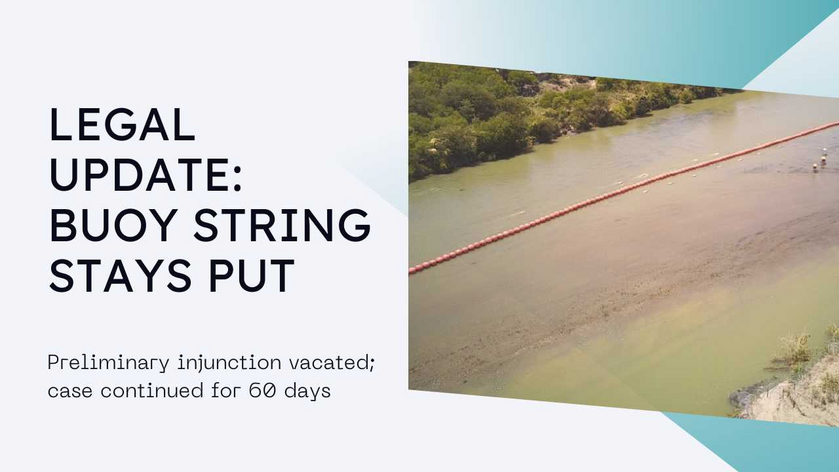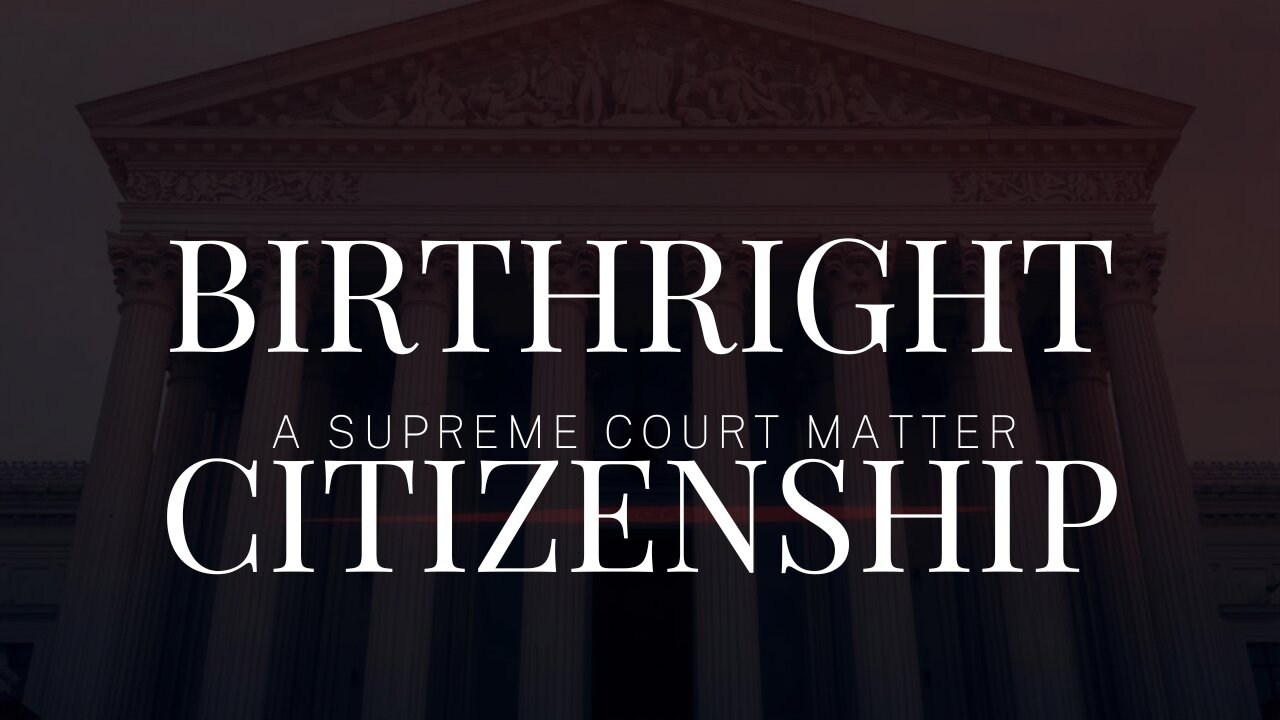Two days ago (July 30) the full Fifth Circuit Court of Appeals ruled that Texas may keep in place the floating barrier it placed along 1000 feet of the Rio Grande near Eagle Pass, Texas. Texas placed that barrier to stop the flow of migrants that the federal government consistently refused to stop. The Biden administration sued and won a preliminary injunction against Texas. Texas appealed to the Fifth Circuit, and at last all appeals are concluded – and the injunction is vacated. This case goes directly to three separate issues: the sorry record of the Biden administration on immigration (which Kamala Harris will now have to defend), possible problems for President Trump to repair in his second term, and the still simmering desire of a third of Texas adults to change State to Republic in their name.
Why the concern with this case
Most cases before Circuit Courts of Appeals don’t have national importance. Congress created them to relieve the burden on the Supreme Court of cases having limited national applicability. Even as is, the Supreme Court receives too many petitions for review of lower-court decisions, and can’t grant them all. Some of these are good cases, too.
But almost all cases reach the Supreme Court through Circuit Courts of Appeals. The Amistad case is one of several rare exceptions, and came under the “admiralty and maritime” category of original jurisdiction. Some cases reach the Court from the highest courts of the several States. Even “cases to which a State is a party” usually begin in district courts.
But occasionally a case with national political and public-policy significance comes to the federal courts. U.S. v. Abbott (1:23-cv-00853, before the U.S. District Court for the Western District of Texas, Austin Division) is one. It touches on one of the most basic rights the States retained when signing onto the Constitution. The Fifth Circuit thus far avoided the weighty Constitutional question – because the federal government presented a very weak case. But this case could come back to the Fifth Circuit – or go directly to the Supreme Court, now or later. When it does, that Constitutional question will be part of certain arguments. That principle is the right of any State to defend itself by itself against any form of invasion.
Operation Lone Star and the Texas buoy string
Gov. Greg Abbott (R-Texas) effectively began the current dispute after the disastrous 2022 Midterms. He declared his State under actual invasion and announced several measures he would pursue to deter and repel that invasion. Those measures take the name of Operation Lone Star, after the State’s nickname. Nor did he act entirely alone; he put together a coalition of border State governors who supported his position.
The measure relevant to the present case was his construction of a riparian barrier near the midline of the Rio Grande, along a 1000 foot stretch of that river near Eagle Pass, Texas. Eagle Pass has seen the most illegal migration activity – until Gov. Abbott started to act. In another action, he strung concertina wire along several fences on the Texas side. (Border Patrol elements cut the wire, so Texas sued them to stop that. That separate case is also before the Fifth Circuit.)
The riparian barrier is a string of buoys (called ballards), with metal disks with serrated edges between them. A net hangs under the buoys to stop people from swimming beneath them. Eight Texas House Democrats sent a letter of protest to Attorney General Merrick Garland, suggesting Abbot was breaking international law. Eight days later they and seventy-nine fellow Democrats from other States wrote to President Biden. So the Justice Department sent Abbott a letter demanding that he take down the barrier. Abbott refused, and said in effect, “So sue us.” So the Feds sued them.
History of the lawsuit
The Justice Department filed in the Western District of Texas, Austin Division. (See docket page, complaint, and amended complaint.) The complaint alleges:
Obstruction of navigable waters, in violation of the Rivers and Harbors Act (RHA) of 1899, and
Conduct to the prejudice of diplomatic relations between the United States and Mexico.
In regard to that last, the Mexican government complained formally about the barrier. No doubt the new MORENA government will complain more vociferously, when, as, and if applicable.
David A. Ezra, seconded to the District Court by Chief Justice Roberts, handed down a preliminary injunction September 6, 2023. It ordered Texas to down tools, not string any more buoys (Texas planned two more such strings), and move the existing string to the northern riverbank. Judge Ezra stated as his reason, that shallow-draft craft (airboats, fishing skiffs, canoes, etc.) could navigate that stretch of the river, if the buoys were not in place.
Immediately Gov. Abbott filed Notice of Appeal with the Fifth Circuit. (See the Fifth Circuit docket page.) At first the Fifth Circuit stayed the injunction pending appeal. But on December 1, they dissolved that stay by a 2-1 vote. Their published opinion is available here, together with a withering dissent by Judge Don R. Willett. He insisted, contrary to the majority opinion by Judges Dana Douglas and Carolyn Dineen King, that the Rio Grande is not navigable along that stretch. Ferry traffic doesn’t count, and neither treaty nor statute can make any river navigable.
Texas goes for the en banc hearing
Texas took a hazardous step: they petitioned for an en banc rehearing. Attorney General Ken Paxton also filed a motion-to-dismiss for failure to state a claim, on December 6. Texas alleged that the Treaty of Guadalupe-Hidalgo is not self-executing and is therefore unenforceable as domestic law. As to the RHA, that is enforceable against persons and corporation, not States.
A report by Newsweek that Judge Ezra had granted the motion-to-dismiss turned out to be utterly without foundation. In fact, Judge Ezra accepted opposition and reply briefs, held a hearing on March 19, and accepted supplemental briefs. On April 26, 2024, Judge Ezra threw out the federal government’s added claims under the Treaty of Guadalupe-Hidalgo. That treaty is not self-executing, and Congress has never passed implementing legislation to enforce the treaty domestically. But the RHA claims remain.
While all this was happening at District Court level, the Fifth Circuit granted the en banc rehearing petition. The appellate court then asked for full briefing, and heard argument on May 15.
Texas wins
By a vote of 11-7 (accounting for concurrences in judgment) the Fifth Circuit decided in Texas’ favor. They have vacated Judge Ezra’s preliminary injunction, and remanded the case. The majority found that the Rio Grande is indeed un-navigable in the stretch in question. Making it navigable would cost far too much in relation to the additional cargo any river boats might carry.
The majority found that ferry traffic, which is cross traffic, does not make a river navigable. In so finding, they evidently decided not to construe the RHA as forbidding any impediments to ferry traffic. Chief Judge Priscilla Richman disagreed – but found that along this stretch, even ferries couldn’t have proper landings at Eagle Pass and on the opposite bank. Perhaps key to that finding was that a bridge spans the Rio Grande near Eagle Pass. But to cross the bridge, one must show documents – and illegal immigrants have none.
Judge James Ho would have gone further, and dismissed the case entirely for lack of subject-matter jurisdiction. He accepted Texas’ argument that Texas was under actual invasion. Judge Ezra had ruled that the Framers did not regard immigration as an invasion. But Judge Ho, in twenty-seven pages, cited Texas’ prior (and colorful) history in acting unilaterally against Mexican bandits. That’s relevant because “migration can be weaponized by one sovereign to inflict damage on another.”
Concurrences and dissents
Judge Andrew Oldham, in his concurrence, clearly showed that he didn’t want to touch the invasion defense at all. Judge Ho roundly criticized him for “duck[ing]” the issue. If this case reaches the Supreme Court, Judge Ho’s analysis will stand in opposition to Judge Ezra’s blithe dismissal.
The two dissents (by Judges Stephen Higginson and Dana Douglas) say flatly that no State may interfere with commerce. But by the theories they advance, absolutely all passage would have to be free. This illustrates the folly Judge Ho pointed out, of avoiding the invasion issue. The majority did not reach Judge Ezra’s refusal to equate immigration with invasion. The dissents take advantage of that, then hold that any river is or can be made navigable with sufficient effort. In fact they asserted that ferries did once cross the Rio Grande at Eagle Pass – and therefore could again. Obviously the majority disagreed that such traffic would be worth undertaking, given the presence of a nearby (and gated) bridge.
In sum, those dissents suggest that their authors contemplate a reinstatement of the ferries that crossed the Rio Grande at Eagle Pass before the building of the bridge. That in turn makes one wonder whether they contemplate the Mexicans building simple beaching ferries to move the migrants across the river without a customs search.
Judge Douglas’ dissent referred to federal claims based on the Treaty of Guadalupe-Hidalgo. But those claims are already dead; Judge Ezra killed them (see above).
Concerning the future of the Fifth Circuit
This table lists all the judges who heard oral argument, and took part in Tuesday’s decision:
Judge | Appointing President | Opinion |
Priscilla Richman (Chief) | Bush Junior | Concurring in judgment |
Edith Jones | Reagan | Majority |
Jerry Edwin Smith | Reagan | Majority |
Carl E. Stewart | Clinton | Dissent |
Jennifer Walker Elrod | Bush Junior | Majority |
Leslie H. Southwick | Bush Junior | Dissent |
Catharina Haynes | Bush Junior | Majority |
James E. Graves, Jr. | Obama | Dissent |
Stephen A. Higginson | Obama | Dissent (Co-lead) |
Don Willett | Trump | Majority (Lead) |
James C. Ho | Trump | Concurring in judgment but dissenting in part |
Kyle Duncan | Trump | Majority |
Kurt D. Engelhardt | Trump | Majority |
Andrew Oldham | Trump | Majority (with separate concurrence) |
Cory T. Wilson | Trump | Majority |
Dana Douglas | Biden | Dissent (Lead) |
Irma Carillo Ramirez | Biden | Dissent |
Carolyn Dineen King (Senior) | Carter | Dissent |
The only reason Judge King was on the case, was that she was on the original three-judge panel. Obviously Chief Judge Richman let her sit with the Actives in the en banc rehearing.
Judge Southwick’s vote in dissent is the only vote difficult to explain. Every other Bush Junior appointee joined with the majority or concurred in the judgment. So what happened to Judge Southwick? No one can know – but then again, Bush Junior was a globalist, not a patriot.
Reagan’s two surviving appointees joined three of four Bush Junior appointees – and all six Trump appointees – in the majority. Judge Willett triumphantly turned his earlier panel dissent into the opinion of the court. Judge Ho, as mentioned, wanted to go further.
Problematic judges
Of all Trump’s appointees, Judge Oldham displayed the most timorous attitude. He, in so many words, told Judge Ho to shut up about the invasion defense. That could present a problem, because of all Trump’s appointees, he is the youngest. In fact he is the youngest member now serving on the entire Court.
The Democratic appointees voted in lock-step to affirm the injunction. Their arguments, like those of Judge Douglas on the first panel, are worse than specious, and border on the disingenuous. Furthermore, Judge Douglas is relatively young – the second youngest, after Judge Oldham. So she will trouble the peace of the Fifth Circuit longer than will any of the other Democratic Actives.
The oldest Democratic Active, Carl Stewart, is the fourth-oldest of all Actives. Of the Seniors, only Judges King (Carter) and Dennis (Clinton) owe their appointments to Democratic Presidents. The oldest living Senior, John Duhé, is inactive – and 91 years old. He will likely die, and then Judge Smith, 78, will go Senior. So Trump might get one appointment, that might not change the balance of the Court. But perhaps a new Trump-appointed Active will bring fresh energy – and back up Judge Ho. The idea of a younger judge treating Judge Ho like a kid and saying, after Leonard Bernstein,
Boy, boy, crazy boy, get cool, boy!
strikes your editor as incongruous.
Where the case goes from here
U.S. v. Abbott absolutely will return to the Fifth Circuit. Whether it goes to the Supreme Court will depend on who is President. On Wednesday, July 24, Judge Ezra ruled that Texas does not get a jury trial. But its affirmative defense of “repelling an invasion” remains, and the Judge refused to strike it peremptorily.
Gov. Abbott quickly filed, with the Fifth Circuit, a petition for a writ of mandamus, to compel a jury trial. Judge Ezra had scheduled trial to begin August 6. At first he denied a motion for stay of trial – but today the federal government asked for a sixty-day continuance! The Fifth Circuit’s en banc opinion threw them for a loop, and they need time to respond. Faced with that, Judge Ezra today filed an “advisement to appropriate panel” indicating trial will not begin next Tuesday. Instead he will call a status conference to determine how best to proceed. He now anticipates trial beginning October 8, 2024.
Gov. Abbott, for his part, posted this in celebration:
https://x.com/GregAbbott_TX/status/1818451287261724981
The Texas Nationalist Movement cautiously welcomed the news.
https://x.com/TexasNatMov/status/1819078209964511652
But in covering a July 24 hearing of the Texas House Committee on Securing Texas from Hostile Foreign Organizations, they reported on “a surprising twist.” Several private citizens testified that the biggest hostile outside interest was not a foreign government, but the United States government. That’s the strongest indication yet of “Texit” sentiment.
Addressing the issues
This case illustrates, above all, the disastrous record of the federal government – and of Vice-President Kamala Harris’ border policies. (Her “border czar” had no Constitutional validity, because the Senate did not confirm her in that role. Nevertheless, she called herself that.) Sen. J. D. Vance (R-Ohio), now a candidate for Vice-President, visited the southern border recently.
https://x.com/TrumpWarRoom/status/1819070157865546063
So this issue is front-and-center in the Presidential election. If trial begins on October 8, it will highlight the issue at the right time for Trump.
The most urgent thing Trump can do is to be President instead of Harris, to protect the integrity of the Fifth Circuit. But suppose Justice Sonia Sotomayor dies (perhaps of complications of diabetes)? Then Trump could do worse than to elevate Judge Don Willett to the Supreme Court. Then he could appoint another judge, hopefully a younger man, to replace Willett – and back up Jim Ho.
The Texas Nationalist Movement will not stop until they achieve secession. If Trump wins, they’ll probably pause their activities. But if Trump loses, having such high expectations of winning, then all bets are off. Even were Texas to prevail in its immigration cases, perhaps a third of Texans would consider secession the simplest solution. That will go double after “General” Liz Prelogar argues for a removal of all immigration barriers – and wins.
Link to:
The article:
https://cnav.news/2024/08/01/foundation/constitution/texas-buoy-string-remain/
Video:

United States v. Abbott:
District Court:
Docket page:
https://www.courtlistener.com/docket/67630985/united-states-v-abbott/
Complaint:
Amended Complaint:
Preliminary Injunction:
Order dismissing the additional “Treaty Claims” in the amended complaint:
Ruling denying a jury trial but also preserving the invasion defense as an affirmative defense:
Order denying Texas’ motion for stay of trial:
Federal government motion for a continance:
Advisement to panel regarding status conferences and further delay of trial:
Fifth Circuit Court of Appeals:
Docket page:
https://www.courtlistener.com/docket/67770228/united-states-v-abbott/
First panel opinion affirming District Court:
https://storage.courtlistener.com/recap/gov.uscourts.ca5.215588/gov.uscourts.ca5.215588.98.0.pdf
En banc opinion reversing District Court:
https://storage.courtlistener.com/recap/gov.uscourts.ca5.215588/gov.uscourts.ca5.215588.255.0.pdf
Video: “Cool” number from West Side Story:
Gov. Abbott’s celebration:
https://x.com/GregAbbott_TX/status/1818451287261724981
TNM’s cautions welcome:
https://x.com/TexasNatMov/status/1819078209964511652
J. D. Vance visits the border:
https://x.com/TrumpWarRoom/status/1819070157865546063
Declarations of Truth X feed:
Declarations of Truth Locals Community:
https://declarationsoftruth.locals.com/
Conservative News and Views:
Clixnet Media























